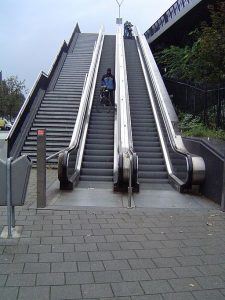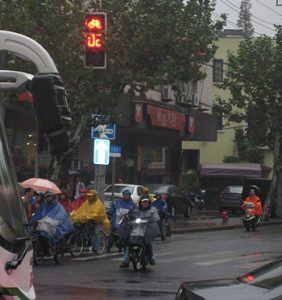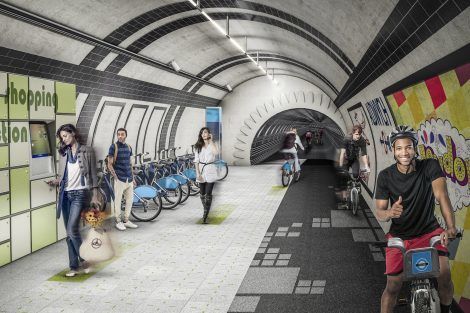July 7, 2016 — Solar-powered bike paths that can melt snow and ice; pollution-eating vacuum towers near bicycle paths; bicycle parking stations with lockers, rest rooms, and showers; and bicycle wheels with rechargeable batteries that help propel riders up hills are just a few of the 70 innovations—some already in place, others still on the drawing board—outlined in a new compilation of inventive ideas aimed at encouraging people to bike.
“Promoting Bicycling Through Creative Design: Innovations for Bicycles and Cycling Facilities” was compiled by Anne Lusk, research scientist in the Department of Nutrition, in partnership with the U.S. Environmental Protection Agency and the League of American Bicyclists, with support from the Helen and William Mazer Foundation.
In a podcast, Lusk talks about ways to make biking safer and easier. See also link below.
“The hope is that these innovations will move the needle faster in getting people to take up cycling,” said Lusk. There are lots of good reasons for doing so, she said, noting that bicycling is good for people’s health and good for reducing greenhouse gas emissions. It may also boost local economies, she said. She cited a 2010 study of a retail area in Melbourne, Australia that found that $31 was generated per hour for each square meter of parking allotted to bikes compared with $6 for similar space allotted to cars—because bikes take up so much less space than cars, thus allowing for more shoppers in the area.

Some of the innovations are already in use—like the bicycle escalator in Trondheim, Norway that works like a ski lift, in which a cyclist seated on his bike puts one foot on a small platform and gets propelled slowly up a hill. Others are still in the idea stage, like one that proposes using old metro tunnels in London for a combination pedestrian park and cycleway.
Lusk thinks the pollution-eating vacuum towers are one of the most interesting ideas, but they also would be extremely expensive to implement. A less expensive idea she likes is solar-powered strings of Italian piazza-inspired white light bulbs strung along bike paths.
Some of the innovations would be hard to accomplish in the U.S., like bicycle paths that run through buildings. There’s one in the Netherlands that runs through the Rijksmuseum in Amsterdam. “We still don’t value and design for bicyclists in the U.S.,” said Lusk. “For instance, architectural renderings of new buildings for U.S. cities still depict only pedestrians and vehicles—not cyclists.”

Lusk is a big fan of the overhead bicycle countdown signals at intersections found in some cities in China. They feature a red bicycle on top, a green one on the bottom, and a red or green countdown number in the middle. “They’re easy to install and cost less than $200,” she said.
She also touts the wide bicycle lanes in Copenhagen, Denmark, and the Netherlands that enable cyclists to ride side-by-side and have conversations. Lusk would love to see these implemented in the U.S., “because bicyclists have friends too,” she said.
Lusk said she’ll add to the list as she discovers new innovations. She also hopes people will send her suggestions.
Her biggest long-term hope is for good bicycle parking options in the U.S. “We have garage door openers and sheet-rocked garages with overhead lighting, so why can’t we also have bike parking rooms with automatic overhead door openers, sheetrocked walls, and overhead lighting?” she asked.
Her short-term wish is for drivers to stop complaining that all bicyclists are a nuisance. “That’s my idea of nirvana—that the environment would make it clear to everyone where to drive and bike and be safe,” she said.
[soundcloud url=”https://api.soundcloud.com/tracks/273702816″ params=”auto_play=false&hide_related=false&show_comments=true&show_user=true&show_reposts=false&visual=true” width=”25%” height=”225″ iframe=”true” /]
photo of London Underline courtesy Gensler
photo of Nijmegen, Netherlands escalator by Havang(nl), via Wikimedia Commons
photo of cyclists at Shanghai bicycle light courtesy Anne Lusk
